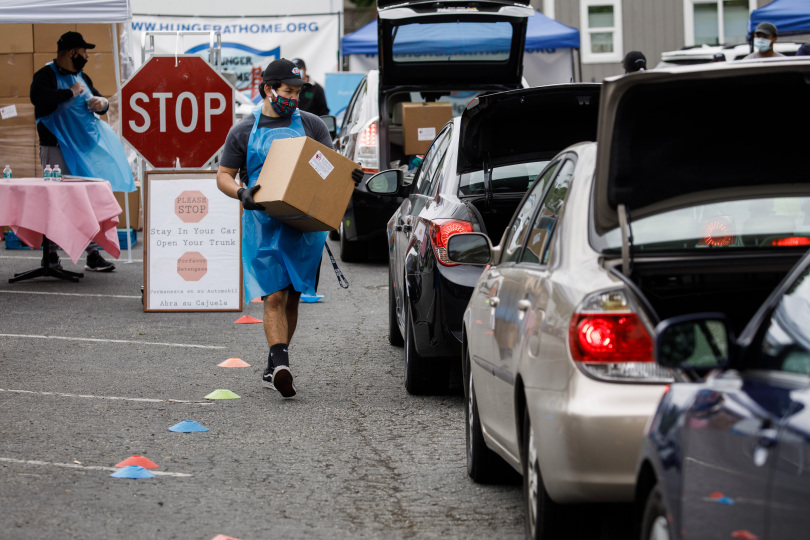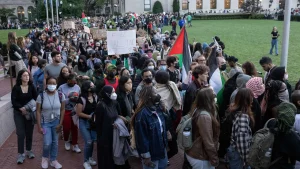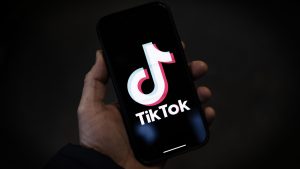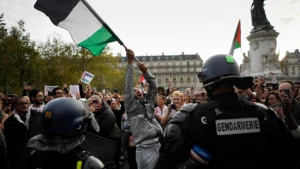The economy might be collapsing in the middle of a deadly pandemic, but the stock market is booming.
For example, The Wall Street Journal reports that the Standard & Poor’s stock index — which measures 500 major US corporations’ stocks — has been rocketing upwards, recently hitting new highs. Its rise has been matched by the tech-heavy Nasdaq index, which is also breaking records. One writer for the Journal says we’ve seen a “remarkable comeback” from the pandemic-driven shut-down. In fact, we can all breathe a sigh of relief, since investors have “brushed aside worries about the nation’s continuing struggle to contain the pandemic, focusing instead on signs of strength in the housing and retail sectors.”
The WSJ isn’t alone in its delirious optimism. Trump has been touting the stock market as his own victory and a sign that life will soon return to “normal.” Meanwhile, Joe Biden is starry-eyed about the future and is promising that if he wins the presidency, he’ll make sure the economy keeps booming for everyone.
While stocks keep climbing, the ruling class is raking in staggering amounts of money. Amazon, for instance, posted a profit of $5.4 billion for April, May, and June, and on July 20, Jeff Bezos made $13 billion in just a single day.
But this stock market boom is a fever dream that is hiding a much darker reality for the working class and oppressed — the people on whose backs the so-called “recovery” is being made.
Economic Collapse
In part, the stock market’s surge has been because capitalists were buying back their own stocks. Buy-backs are a method for driving up stock prices and making more money for investors — so much so that the central bank of the U.S., the Federal Reserve, had to restrict such moves.
But above all, the stock market rally over the past few months has been because of the vast amounts of money the federal government is dumping into capitalist coffers. The Federal Reserve has given away trillions of dollars by buying capitalist firms’ bonds and other financial instruments to “heat up” the economy. And Democrats and Republicans in Congress passed a $2.2 trillion “aid” bill of taxpayer money to support those in need — cash that was, overwhelmingly, a gift to the ruling class itself.
Moreover, the Federal Reserve is pairing these gifts to the capitalists with extremely low interest rates, making it easier for banks to borrow and loan and encouraging capitalists to gamble through risky financial moves. The rally also shows investors’ optimism about making more profit in the future as Democratic and Republican politicians are reopening the economy after the lockdown.
But there is a radical disconnect between what the ruling class’s stock tickers say and what happens to the working class and oppressed. For starters, the reopening is happening regardless of the fact that the reopening puts workers and the oppressed at deadly risk of catching a disease already killing hundreds of thousands in the U.S. (especially Black and Brown people). Members of the ruling class have been demanding this reopening for months — like in the pages of Bloomberg and The Wall Street Journal — regardless of what happens to “essential workers” and others.
More than this, stocks are, above all, for the ruling class. The richest 10% of Americans own about 90% of the stocks. Gains in the stock market mean more profits for the rulers, not a sign that society is somehow getting better for the masses.
And even though Trump is celebrating the economy’s “super” recovery, millions upon millions are being thrown out of work. In April, May, and June, the unemployment rate was 12.9% overall, but much higher for Black (16%) and Latinx (17%) people. Monthly unemployment claims reached historic levels during the pandemic, topping 6 million claims in a single week in March, August saw a relative decline in unemployment — and yet unemployment is becoming increasingly permanent rather than temporary.
And huge capitalist firms are announcing major layoffs, as are city governments. Another resurgence of COVID-19 is not just possible, it’s already here. The threat of future shutdowns looms, and with it comes the threat of higher unemployment. Meanwhile, the trickle of additional unemployment payments dwindled from $600 a week to $300, and the number will only keep falling from there. Millions who have no health insurance, or who lost it with their jobs, now face staggering hospital bills from getting sick in the pandemic.
On top of all of this, an eviction crisis hovers over the millions of workers and oppressed who can’t pay their rent. The opening of the “eviction floodgate” has been postponed again and again — but that won’t last forever. And those moratoriums on eviction often don’t mean much. Since the pandemic began, tens of thousands have been evicted.
We recently saw a sign of just how deep the crisis this time really is — and what a fantasy the stock market boom is. During the pandemic, the U.S. Gross Domestic Product — a key way to measure a country’s overall economic output — has collapsed, falling by a 32.9% annual rate. This is the biggest fall in GDP since records started being kept in 1947.
Not a Temporary Problem
The ruling class and their lackeys are constantly touting the fantasy of a quick recovery and rejecting the idea of a long-term economic disruption. But the crisis this time isn’t just a blip. The pandemic is only intensifying a crisis that has been going on for decades.
Corporations and banks survive and grow only on the basis of the profits that bosses extract from workers — the source of all profit. But, as Marxist economist Michael Roberts points out, capitalist firms have been less and less profitable since the mid-1990s, part of a much longer trend of falling profit rates since the 1980s. This is, in important part, because capitalists constantly try to decrease the amount of “living labor” by workers they rely on (through automation, for example), and to increase the labor-saving machinery and techniques they use in order to become more efficient. All this tends to keep driving down the profit rate.
As profitability overall falls, there are few places for capitalists to invest in the productive economy with a decent return. And this drives capitalists instead to dump more money into risky financial-system gambles. Those moves cause the buildup of financial bubbles waiting to pop. That’s exactly what set off the last breakdown of capitalism in 2007. Then, investors’ risky speculating in housing-market financial instruments helped drive a housing boom. But that gambling was wildly disconnected from the real economy — from people actually being able to pay their mortgages, for example — setting in motion a global economic downturn.
Now, that same dynamic isn’t just being repeated, it’s being put on steroids. The Federal Reserve and Congress have pushed far more money into the pockets of capitalists this time around than they did after 2007. And when the Fed buys up bonds in capitalist firms, it’s basically guaranteeing that it will protect firms against losses,only encouraging further gambling.
This isn’t all. Corporations have racked up major levels of debt in trying to overcome the slowdown in their extraction of profit. Some tech companies are booming, but medium and small corporations are in dangerous positions because of their debt. Even moderate disruptions to supply chains or sales could set off a chain reaction of economic disaster — and this in the age of catastrophic climate change, a raging pandemic, and a looming financial collapse. The imperialists who run the International Monetary Fund call this debt a “ticking time bomb.”
Meanwhile, federal, state, and local governments have been plunged into even further levels of debt because of the massive payouts going mostly to the ruling class and because of the closing of businesses, increased unemployment, and decades of tax cutting. All this is leading to a projected $555 billion budget shortfall in state governments alone through 2022.
In other words: capitalism is convulsing in a crisis that’s been developing for decades. There can be no “return” to a “normal” before the coronavirus. Capitalism’s “normal” is the constant cycle of crises.
What’s next? Austerity, Attacks on Workers, More Cop Violence, and More Imperialism
What does all this mean for the working class and oppressed?
First, it means more austerity. In other words, we’ll see intensified attacks on public, tax-funded services, like public education, and probably on social services like medicare, medicaid, and social security. We’ve already been witnessing the attempts to dismantle the U.S. Postal Service long before Trump tried to use the USPS to disrupt the counting of mail-in votes. With austerity comes the slashing of jobs in both the private and public sector. Already in the pandemic 1.2 million government workers have been fired or furloughed. Layoffs and furloughs in the private sector are sweeping, especially in the transportation, service, and hospitality industries.
These job cuts are a sign that bosses and politicians will be focusing on ramping up their attacks on workers themselves. Not only will workforces be “trimmed”; the crisis of profitability means the goal of bosses, as well as Democratic and Republican politicians, will be to find ways to squeeze workers even more to ramp up their productivity and hours while freezing or slashing their pay, benefits, and job security.
And the attack on workers means, above all, more intense attacks on unions and on collective bargaining rights — like those of public sector unions (of teachers and bus drivers, e.g.) given the budget crisis. In fact, New York City recently passed an austerity budget including cuts to social programs — and it’s eyeing major attacks on government workers to help make up the shortfall.
Unions are usually led by a layer of bureaucrats who act like a wing of management, offering to slow the attacks of the bosses at the cost of keeping workers demobilized and passive. Still, unions are an important obstacle standing in the way of the bosses’ unfettered need for profits. It’s no coincidence that after the 2007 crisis, Wisconsin’s governor took aim at public sector workers’ collective bargaining rights.
And crucially, the ongoing crisis will bring with it even more police violence. The U.S. is being shaken by a mass struggle against the white supremacist policing that capitalism needs, and many Black and Brown youth are showing they’re willing to take up a militant fight against the agents of the ruling class. But cops are going to be more, not less, central to the ruling class in the years to come. Mass layoffs and evictions loom, and Black and Brown people are disproportionately affected by both. Black and Latinx people also make up the majority of the “essential workers” being forced back to work in the pandemic.
As the pressure on BIPOC mounts, police will be a key way that the ruling class tries to maintain “order,” intimidating, harassing, and murdering Black and Brown people to prevent or stop another uprising — and this, despite the fact that Black and Brown communities are already targeted for deadly white supremacist cop violence. It’s no coincidence that, after all the promises of reform, all the kneeling cops, and all the streets painted with “Black Lives Matter,” cops just keep on killing. And if another wave of militant struggle by workers breaks out as capitalism scrambles to secure its profits, cops will be the tip of the spear for attacking strikes.
But we can’t limit our view to the U.S. alone; capitalism is global. As the capitalists become more and more desperate, the pressure keeps building for even more U.S. imperialist violence across the globe. The rulers need that violence to secure the flow of commodities, open up new sectors of profitable investment, fuel the big business of military action, and divert attention away from the mounting social, political, and economic pressures inside the U.S.
Under Trump the imperialist machinery has been in full swing, regardless of his rhetoric about the U.S.’s isolation from the world. Trump’s administration, for example, brought the world to the brink of another nuclear war, this time with North Korea; it orchestrated the failed coup against Maduro in Venezuela as well as the successful one against Morales in Bolivia; and it’s building up the rivalry with U.S. main global opponent China.
Not that we should be under any illusions about Biden or the Democratic Party. Both are fully imperialist in supporting those coups and in their anti-China rhetoric and stance. A military conflict with China is almost certainly coming, though probably not in the near future. But the need for profit and for a jump-start to capitalist accumulation are driving the ruling class towards renewed attacks on countries across the globe.
Where to From Here?
There will be no return to normal. The current crisis is bringing with it a period of more intense class struggle. What does that mean for the working class and the oppressed?
First, the crisis shows us that it’s the working class that has the main power to squeeze, interrupt, and stop the flow of the thing the rulers care about most — profit. That means they’re the force in society best able to fight back against the current and coming attacks.
But second, it shows how crucial the struggle inside unions is, especially in public sector unions, which are facing and will face some of the most intense attacks and layoffs, and which hold key strategic positions in the disastrous reopening of the economy. They transport workers, for example, and they’re told to take care of workers’ children while their parents are forced back to their jobs. And public sector workers like teachers are among the most militant, organized, and class conscious. Even though the unionization rate in the U.S. remains low — about 10% overall — unions are key organizations of the working class, and they will be important fronts in the ongoing class war. That means it is essential to combat, push leftwards, and overthrow the reactionary, bureaucratic leadership of those organizations. We badly need to make unions into bastions of revolutionary working class power that can defend themselves and fight back against the bosses as well as the Democratic and Republican parties.
Third, the crisis shows how important it will be to build bridge organizations between the unemployed and organized labor. The huge masses of unemployed can be a major brake on the ability of workers to fight bosses, since higher unemployment makes it easier to replace those who refuse to work. History holds some key lessons on what that could look like.
But a working class struggle can’t win without an uncompromising, radical struggle against cops and white supremacy — just like that struggle needs to link up with workers organizing in a large-scale way if it’s to gain real power to destabilize the ruling class. The crisis and the uprising show how important it is to connect and coordinate the anti-cop struggle in the streets and the fight of workers against the bosses who will be intensifying their attacks. We’re already seeing the power and potential of that kind of connection, with athletes engaging in political strikes against police violence and with the many strike and workplace actions by workers in solidarity with the uprising. One model to look towards is the SEIU campaign to “Drop the Cops.”
Only a mass and coordinated response — of workers and of those struggling against cops in the streets — can seriously challenge the power of the ruling class. And only that kind of response can stop the rulers imperialist, deadly adventures across the globe.
We can’t build that kind of fight back without an organized, mass, and revolutionary socialist party — one that is totally independent of the capitalist parties, and rooted in struggles in the workplace and the streets. In the new era of increased class struggle, we need to build that party to defend ourselves and strike back at the ruling class.










